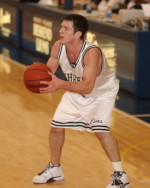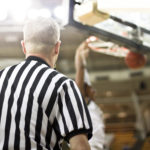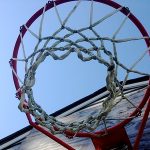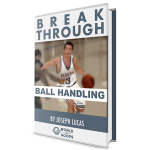If you found this post before the first two episodes in this Definitive Guide to Ball Handling (ball handling introduction & why and when to dribble). Just like most skills, dribbling mechanics are important. This includes: how you hold the ball, the posture and stance of your body, and how you physically/mechanically should dribble the ball. Before we dive in, I do want to mention a few related basics.
The Hands – finger & hand position on the ball
Obviously, the connection between your hand and the ball is important. We want to give ourselves as much control over the ball as possible. At some point every player has probably had a coach tell them to dribble with their “fingertips”, while you do want to use your fingertips when you dribble, this doesn’t mean you should not touch the ball with your palm. I think some coaches say to use fingertips because they don’t want players just pounding the ball with their palms. But, really…the palm needs to be on the ball often as well. The more surface area of the hand that is in contact with the ball, the more control a player has of the basketball.
The fingertips and finger pads do the “controlling” of the ball with the palms giving some extra control over the ball
The fingers should be spread fairly wide and firm (similar to how they are spread when shooting the basketball)
The hand should be somewhere on the top half of the ball (so you don’t “carry” the basketball)
Catching the ball
A player should always make an effort to catch the ball with two hands. If it is a long pass or the defender has a chance to make a play at the ball, the offensive player should come TO THE BALL. Once a player catches the ball they should hold it with the correct finger and hand position (covered in Ep. 2).
Stance / Triple threat
Almost every coach teaches players to get into triple threat when they catch the ball. Sometimes they do so to the extent that every single time a player catches the ball they first think to go into triple threat instead of taking advantage of something immediately available (like a quick reversal pass, an open shot, etc.). That said, triple threat is a good habit and does make a player a threat to the defense.
Pivot foot
Establishing a pivot foot goes hand in hand with triple threat and it is important if a player is going to utilize non-dribble moves like a jab step. There is, maybe surprisingly, a lot of disagreement across the coaching community about which foot a player should use as a pivot foot. We have taken on this topic in another area so if you click this link (Establishing a Pivot Foot) you can see more info on which foot to use as a pivot foot.
Okay – moving on to the mechanics…
Posture & Stance
Dribbling the ball is so critical on the basketball court for enabling a team to score, but it also gives the defense the opportunity to steal or knock away the ball. When dribbling the ball, players need to put themselves in a good stance & posture to maximize their success. They also need to make sure they are protecting the ball. Here are some of the keys:
Athletic stance
Just like the athletic stance of a triple threat position players need to make sure they are in an active stance. The knees should be bent, the player should be bent slightly forward at the waist, the back should be fairly straight, eyes straight facing the basket (and up to see your teammates and the defense), feet just wider than shoulder width…above all we want to feel comfortable with a strong, balanced stance.
Body position
The athletic stance is fine when a defender isn’t pressuring a ball handler or a ball handler is alone. However, when a player is guarded tightly, we want to be sure to keep our body between the ball and the defender. This makes it much more difficult for the defender to knock away the ball.
Off arm
Sometimes called a “guard” arm. We want to keep the non-dribbling arm up or ready as an additional shield. The off-arm should stay bent at the elbow. That forearm can be used to brace against a defender when they pressure. When an offensive player handling the ball extends the off arm that can often be called an offensive foul. Sometimes it is good to keep the first firm to ensure you have a strong brace. This is critical, but you do have to be careful.
The dribble itself
When a player actually dribbles, the ball is pushed into the floor by extending the elbow and flicking the wrist down. The dribble should be firm and controlled. The player should keep the ball in the hand as long as possible then once the ball comes up off the floor, the player should “catch it” with their hand, using the fingertips and fingerpads to control it. When it is “caught” the hand cushions the bounce back with the hand and wrist. The dribble is going to be at various heights depending on the situation, but generally a lower dribble gives more control and a higher dribble gives less control. Whether you dribble low or high, keeping the ball in your hand as long as possible is very important because this gives you control over the ball and gives the defender less chance to steal or knock away the ball
To sum this lesson up, when handling the ball you want to be aware of what is going on with your head up. You want to be comfortable, balanced, and athletic in your stance. But you always want to be firm and strong in your position and in the way you are dribbling the ball.
 He has 25 years of experience playing basketball, training basketball players, and coaching basketball. The World of Hoops provides intelligent and intense basketball training to take basketball players to the next level.
He has 25 years of experience playing basketball, training basketball players, and coaching basketball. The World of Hoops provides intelligent and intense basketball training to take basketball players to the next level. How to Deal With Basketball Referees – A guide for Players
How to Deal With Basketball Referees – A guide for Players The Pivot Foot – Which Foot to Use – Permanent vs. Switching
The Pivot Foot – Which Foot to Use – Permanent vs. Switching The Best Basketball Gifts and Products
The Best Basketball Gifts and Products A Great Investment – Breakthrough Ball Handling
A Great Investment – Breakthrough Ball Handling




Speak Your Mind